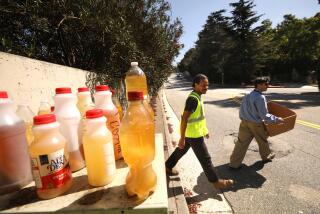‘Bottlemania’ by Elizabeth Royte
- Share via
Bottlemania
How Water Went on Sale and Why We Bought It
Elizabeth Royte
Bloomsbury: 248 pp., $24.99
In 2006, Americans consumed, per capita, more than 25 gallons of bottled water -- twice as much as in 1997 and almost five times as much as in 1987. And what ignites Elizabeth Royte’s reportorial spark in “Bottlemania” -- at least initially -- is the ecological cost of all those plastic empties: We discard between 30 billion and 40 billion bottles of Poland Spring, the most popular brand, in a year.
Like her previous book, “Garbage Land: On the Secret Trail of Trash,” this tautly paced volume more closely resembles a travel narrative than a tree-hugging jeremiad. Royte doesn’t traffic in platitudes, moral certainties or oversimplification; she’s unafraid of ambiguity. Seamlessly blending scientific explanation and social observation, she pursues the course of Poland Spring back to its source in Fryeburg, Maine.
“Fryeburg is tied up in fits,” she writes. “Its abundance of fine water has cast its unwitting residents into the middle of a social, economic, and environmental drama.” Her mordant wit comes in handy: “It’s easier to picture kids guzzling beer out here than deer nuzzling around mossy springs,” she notes. “But Fryeburg, for all its out-of-season torpor, once bustled with economic activity: sawmills and timber operations, a shoe manufacturing plant, a couple of machine shops, corn shops, and dozens of thriving dairy farms. Now, it has the water-extraction business, which contributes nothing to the town’s long-term economic welfare.”
What drives this obsessive thirst -- this compulsion to pay for something we can essentially get for free? Royte characterizes the nationwide craving for bottled water, “in a country where more than 89 percent of tap water meets or exceeds federal health and safety regulations,” as both an outrageous marketing coup and an unparalleled social phenomenon. Beginning in the late 1970s with Orson Welles’ high-toned television pitches for Perrier, bottled water has been promoted for its snob appeal as much as its health benefits. Jennifer Aniston’s recent spots for Smartwater strike Royte as typically absurd. “Some ads depict her naked and others place her, clad, in an elegant restaurant, where her plastic water bottle looks, to someone with my peculiar mindset, like litter amid the crystal stemware.”
Royte’s “peculiar mindset” is that of an unabashed tap-water enthusiast who savors the irony that “purified” water from municipal sources -- Dasani and Aquafina, as opposed to bottled spring water or mineral water, like Perrier -- accounts for 44% of U.S. bottled-water sales. If her personal disavowal of bottled water borders on the puritanical, it also comes across as pragmatic: “Foie gras tastes better than chopped liver. That doesn’t mean I’m going to buy it. I don’t need to spoil myself. I don’t want to get used to expensive things . . . that might . . . disrupt the social and environmental order.”
Like any good travel writer, Royte possesses an intellectual curiosity that continually lures her off the beaten path. The second half of “Bottlemania” takes a sharp turn, upending many of the author’s previous assumptions about tap water.
“I decide to visit Kansas City,” she writes, “where the public utility sucks from the Missouri River something that resembles chocolate Yoo-Hoo and turns it into water so good that national magazines shower it with awards and even the locals buy it in bottles.” All along the Missouri and the Mississippi, cities drink from and discharge into the same river. Visiting a municipal water-treatment plant, Royte is alternately impressed and appalled: “[T]he filtering process mimics, in a supercondensed time frame, the purifying processes of nature. It’s the same ecosystem service provided for free in such places as Fryeburg, Maine, by glacier-made beds of sand and gravel.”
Royte knows when not to intrude, when to let a devastating quote or damning exchange stand on its own:
“What do you do with the atrazine [an herbicide] once you filter it out?”
“We put it back in the river.”
It seems that because of oil spills, industrial discharges, agricultural runoff, animal waste and sewage (both treated and raw), tap water is far from risk-free. Suddenly, the stainless-steel extraction pipes of Poland Spring don’t seem quite so redundant, and Royte admits that after her tap-water investigations, “I’m not immune to the appeal of springwater.” Yet the conclusion of “Bottlemania” is more thoughtful than despairing, even though much of what we’ve learned isn’t comforting. If our future really does include drinking reclaimed or “repurified” wastewater, Royte is willing to hold her nose and remain philosophical. “As bad as toilet-to-tap sounds,” she concludes, “I have to remind myself: all water is recycled.” *
Mark Coleman is the author of “Playback: From the Victrola to MP3, 100 Years of Music, Machines, and Money.”
More to Read
Sign up for The Wild
We’ll help you find the best places to hike, bike and run, as well as the perfect silent spots for meditation and yoga.
You may occasionally receive promotional content from the Los Angeles Times.










